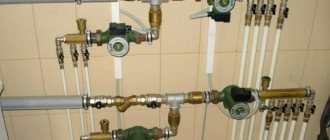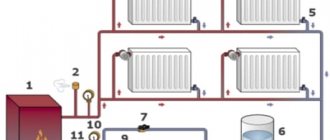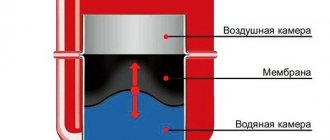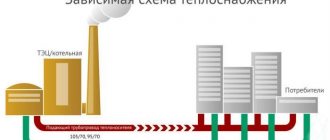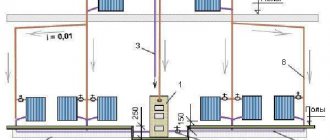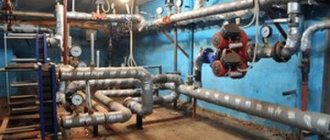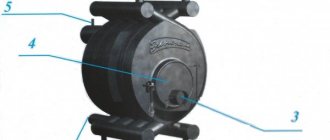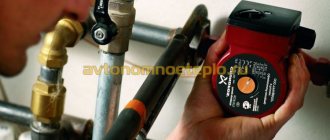Make-up – adding coolant (water) to the heating system. This is one of the standard maintenance operations. In open heating systems with gravitational circulation of water, the most intense evaporation occurs through the expansion tank. For systems of this type, replenishment must be carried out before each heating season, and sometimes during it. The closed type is not so susceptible to loss of coolant, but also requires periodic replenishment, at least once every 3-4 years. There are many reasons for a decrease in coolant level in closed heating systems:
- During operation, especially during the first and test runs before the autumn-winter season, automatic air vents are triggered quite often. These devices are located in the highest sections of pipelines. Therefore, the coolant temperature near them is the highest. During the air release process, a large amount of water vapor is released;
- Removing air pockets from heating radiators is accompanied by the leakage of a fairly significant amount of water;
- When the heating system is operated at maximum conditions, which is typical for solid fuel boilers, the safety valve is periodically activated. In this case, replenishment must be organized promptly, since a lack of coolant can lead to overheating of the heat exchanger and damage to the lining layer of the firebox of a solid fuel boiler;
- Violation of the tightness of pipelines, risers, radiators, etc. In each specific case, the leak may be insignificant and unnoticeable. But if the installation is done carelessly and there are many micro-leaks, the coolant level drops quite quickly.
What can a critically low coolant level lead to?
- Reduced efficiency of the heating system and the appearance of numerous air pockets;
- Overheating of the coolant, leading to shutdown of the boiler;
- More intense corrosion process inside pipelines and radiators, in places of contact with air;
- The risk of failure of the boiler or temperature-control equipment increases significantly.
Operating principle of the coolant
In practice, all owners of autonomous heating systems, without exception, sooner or later are forced to solve the problem of reducing the volume of coolant in the heating system and use make-up pumps.
The only difference is that in open systems the coolant decreases systematically and quite quickly, while in closed systems it decreases more slowly.
When circulating through the heating system, the coolant is heated by the heat generator, passes through the radiators and gives off part of its heat to heat the rooms. Then the coolant, which has already cooled, returns to the boiler and heats up again to go to the heating radiators. This cycle repeats over and over again as long as the heating system is running.
If the volume of liquid decreases significantly in volume, then, in addition to reducing efficiency, the heating equipment may fail, and the system will become airy. In order to avoid such a nuisance, they use make-up pumps for the boiler room, integrating them into special automatic make-up units.
Which pipe should I pour antifreeze through?
This is what the feed tap looks like
Before you get started, you need to know how to fill your heating system with antifreeze. There are two types of heating circuits. In one, the coolant is in contact with air, and in the other, circulation takes place in a completely closed circuit. The operating principle of these circuits is different, but they are united by the fact that antifreeze can be used in both. To pour antifreeze into the heating circuit you will need a pump. Coolant can be poured into open circuits in buckets, but in the case of non-freezing liquid this will take too long.
Antifreeze is poured into the heating system, in theory, through a make-up valve, if one is available. If it is not there, then the following options are possible:
- through the battery plug;
- through a pipe under a closed expansion tank;
- through the boiler.
To fill the heating circuit with antifreeze through the radiator plug, you need to unscrew it and screw in a tap instead.
A pump is connected to this tap, thanks to which antifreeze enters the pipes. After filling the heating system with antifreeze is completed, the tap remains at the end of the battery. This will allow you to recharge the system during operation, as well as use it as a drain when you need to empty the circuit of coolant.
In closed circuits there is a membrane expansion tank, for which there is a separate pipe. When the system is full, it is recommended to temporarily remove the expansion chamber. Is it possible to fill the heating system with antifreeze when the tank is not removed? It’s possible, but most likely, after this the expanzomat will still have to be removed and reconfigured. The expansion tank is installed both up and down.
The second method is more preferable, and the valve is installed on the pipe in different ways. Some installers install American valves with a tap in such a way that the shut-off valves remain on the circuit, while some, on the contrary, install them in such a way that the tap is removed together in the expansion chamber.
In the first case, there will be no problems with filling the circuit through the expansion tank pipe. In the second case, you will need to install such a tap. A hose from the pump is connected to the shut-off valve and antifreeze is poured into the pipes. Upon completion of the work, the ball valve is closed and the expansion chamber is installed.
Even if you do not have recharge coming from the pipes, this does not mean that there is none at all. Modern boilers always have a make-up pipe. For this reason, installers may not install another tap in the circuit itself. The boiler feed, if the system operates on water, is often connected to the water supply. If antifreeze is used, the pipe remains free and a pump can be connected to it.
Do you know that you can do alternative home heating with your own hands and not pay contractors? It's possible.
Read about why you sometimes have to resort to heating a wooden house with electricity here.
Reasons for reducing coolant volume
In the case of an open heating system, the coolant constantly evaporates from the expansion tank, since the liquid is hot and the tank is open. In addition, evaporation also occurs in the air vent, in the safety valve, when pressure increases, and at equipment connections (microleaks form). The internal surfaces of metal pipes are subject to constant corrosion, which reduces their thickness, and, as a result, there is more space unfilled with liquid in the system.
When air is removed from the system through Mayevsky's taps, coolant also leaks. In addition, during regular maintenance work, part of the liquid is drained when dirt filters are cleaned, pipes are repaired, or faulty equipment is replaced.
Types of water pumps for pumping constant pressure water
Water supply pumps for constant pressure are divided into products with a “wet” / “dry” rotor:
- Units with a wet rotor are almost silent. The equipment is introduced into the system through an insert into the water supply pipe and works as a flow pump. The devices operate automatically and do not require operator attention or additional settings. Lubrication of working units is carried out using liquid. Products with a “wet” rotor are used, as a rule, to service one water intake point, for example, a washing machine or dishwasher, since the increase in pressure is insignificant.
- NPDV with a dry rotor are more powerful and have high performance. At the same time, the devices require regular maintenance (lubrication of working units) and have a higher noise level than similar units of the first type. Such pumps are capable of significantly increasing pressure and are used for large water supply systems with several water intake points.
Constant pressure pumps can be purchased for organizing high-quality water supply to an apartment, cottage, private house, as well as for arranging irrigation systems on a personal plot, pumping water from reservoirs, and other tasks (pumps located in another section of the site are used for pumping gas).
Manual heating system recharge
If the house has an autonomous heating system and there is no public water supply or the water is often turned off, you can get out of the situation by using a hand pump, through which the system is recharged, and take liquid, for example, from any available container, bottle or jar.
Tip: You can use a classic pressure test pump as a booster pump to feed your heating system.
The make-up is connected before the circulation pump to the “return” of the heating system. This is necessary because at this point the coolant temperature is lowest and the pressure is minimal.
Manual feeding has its disadvantages:
- high and constant labor costs;
- you have to constantly monitor the marks on the pressure gauge or in the expansion tank.
This problem is easily solved by installing a booster pump in the heating system.
To control the pump you need:
- check valve;
- pressure switch or electrical contact pressure gauge;
- storage tank (if there is no central water supply, if water is used as a coolant) or if non-concentrated antifreeze is poured into the system (when its concentrate is used, simply add water)
How to pump antifreeze into the heating system
Before pouring antifreeze into the heating system, make sure that the pipes and heat exchangers are clean. If necessary, the entire circuit is first cleaned. To pour antifreeze into heating pipes correctly, you need to completely fill all the voids in the circuit so that there are no air pockets left. Air can only accumulate in batteries, if, of course, the circuit is made without errors. If air pockets accumulate somewhere in the circuit besides the batteries, then air vents are installed there. How to pump antifreeze into the heating system:
- connect the hose from the pump for pumping antifreeze into the heating system to any pipe through which liquid can be poured;
- turn on the supercharger;
- when the pressure gauge needle reaches a reading of one and a half atmospheres, the pump turns off;
- air is drained from all radiators;
- the pump is turned on again to pump antifreeze into the heating system until the pressure again reaches the previous level;
- check the presence of air in the heat exchangers and places where it may accumulate.
After the procedure is completed, the boiler is turned on. After it has been running for some time, about a day, you need to check the circuit again for the presence of air in it. Also pay attention to the pressure gauge. There should be one and a half atmospheres in the circuit. If the pressure gauge readings do not match, adjustments must be made. Most often you have to recharge the system, although it is possible that you will need to drain a certain amount of coolant.
Before pumping antifreeze into the heating system, you can immediately open all air vents. In this case, you need to place some kind of reservoir under each Mayevsky tap; a half-liter jar will do. The hole in the tap is very small, no thicker than a needle, so a flood is not expected.
It is more convenient to use the help of another person, since filling a closed heating system with antifreeze is much more convenient and faster for two people. It is necessary for someone to monitor the operation of the pump, the level of antifreeze in the tank from which it is pumped, and the pressure in the circuit. The second person monitors Mayevsky’s taps and closes them one by one when coolant flows out of the hole.
Operating principle of the automatic recharge unit
Once a drop in system pressure is detected, the adjustable pressure sensor is activated and the pump contacts are closed. The coolant is topped up either from the water supply or from a storage tank. After reaching the required coolant pressure in the system, the pump turns off.
This device has another undeniable advantage - using a make-up pump you can pump coolant into the system without disassembling the heating system. This may be necessary to repair or replace the coolant.
How to choose
The heating system's make-up pump has a different task than the circulation pump, which ensures the movement of the coolant along the heating circuit. The charge pump should provide more pressure with a small flow. Vane, vortex and close-coupled pumps are suitable.
Make-up equipment usually has a low efficiency (only about 45%). But in this case this is not significant. The heating booster pump only switches on periodically and does not operate for long.
When purchasing a recharge pump, you should pay attention to:
- For the pressure that is needed. It must necessarily be higher than the pressure in the “return” of the heating system, and, in addition, it will need to overcome the resistance of the pipeline and pressure sensor.
- For expenses. For closed heating systems, a leak of approximately 1/2 percent of the total volume of coolant in the boiler circuit and heating system is considered normal.
The volume of coolant is determined either empirically or at the rate of about 15 liters/kW of boiler power.
